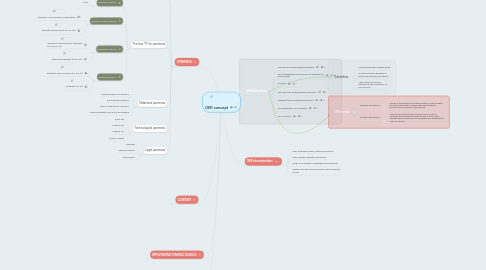
1. TOOLS
1.1. Content management systems
1.1.1. EduCommons
1.2. Development tools
1.2.1. Connexions
1.3. Social software
1.3.1. Wikis
1.3.2. H2O
1.3.3. OSLO research
1.4. Learning management systems
1.4.1. Moodle
1.4.2. Sakai
2. CONTENT
2.1. Learning resources
2.1.1. Courseware
2.1.1.1. - MIT OCW
2.1.1.2. - ParisTech
2.1.1.3. - Japan OCW Consortium
2.1.2. Learning objects
2.1.2.1. MERLOT
2.1.2.2. Connexions
2.1.2.3. ARIADNE
2.1.3. Collections and journals
2.2. Reference collections
2.2.1. Internet Archive
2.2.2. Google Scholar
2.2.3. Library of Congress
2.2.4. Wikis
3. IMPLEMENTATION RESCOURCES
3.1. Licensing tools
3.1.1. Creative Commons
3.1.2. GNU Free Documentation License
3.2. Best practices
3.2.1. CMU (design principles)
3.3. Interoperability
3.3.1. IMS
3.3.2. SCORM
3.3.3. OKI
4. OPENNESS
4.1. Level of access
4.1.1. Access to editing tools
4.1.2. Level of expertise required to revise or remix
4.1.3. Meaningfully editable
4.1.4. Source-file access
4.2. Social openness
4.3. The four “R” for openness
4.3.1. Permission to REUSE
4.3.1.1. None
4.3.2. Permission to REDISTRIBUTE
4.3.2.1. Attribution-NonCommercial-NoDerivatives
4.3.2.2. Attribution-NoDerivatives (CC BY-ND)
4.3.3. Permission to REVISE
4.3.3.1. Attribution-NonCommercial-ShareAlike (CC BY-NC-SA)
4.3.3.2. Attribution-ShareAlike (CC BY-SA)
4.3.4. Permission to REMIX
4.3.4.1. Attribution-NonCommercial (CC BY-NC)
4.3.4.2. Attribution (CC BY)
4.4. Didactical openness
4.4.1. Allows discussion of curriculum
4.4.2. Allows editing curriculum
4.4.3. Allows contribution to curriculum
4.4.4. Allows collaboration on curriculum designing
4.5. Technological openness
4.5.1. Allows use
4.5.2. Allows re-use
4.5.3. Allows re-mix
4.5.4. Allows all sharing
4.6. Legal openness
4.6.1. Copyright
4.6.2. Creative commons
4.6.3. Public domain
5. OER Definitions
5.1. The William and Flora Hewlett Foundation
5.2. OECD (Organization for Economic Co-operation and Development)
5.3. UNESCO
5.4. The Cape Town Open Education Declaration
5.5. Wikipedia (Open Educational Resources)
5.6. The Wikieducator OER Handbook
5.7. OER Commons
6. OER characteristics
6.1. Freely accessible content, media and resources
6.2. Freely reusable copyrights and formats
6.3. Design is considerate of bandwidth and accessibility
6.4. Freedom and openness as principles in their production and use
7. Similarities
7.1. Encompass all types of digital media
7.2. Include free use for educational purposes by teachers and learners
7.3. Cover both use and reuse, repurposing, and modification of the resources
8. Differences
8.1. Nature of the resource
8.1.1. Several of the definitions limit the definition of OER to digital resources, while others consider that any educational resource can be included in the definition.
8.2. Source of the resource
8.2.1. While some of the definitions require a resource to be produced with an explicit educational aim in mind, others broaden this to include any resource which may potentially be used for learning

